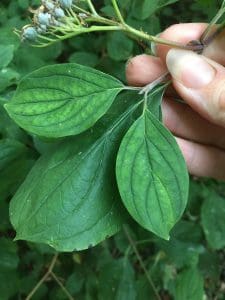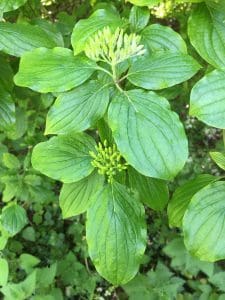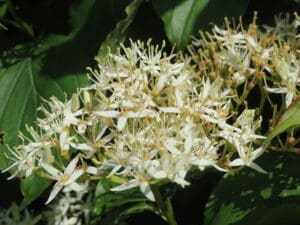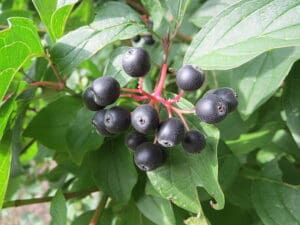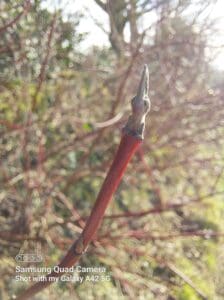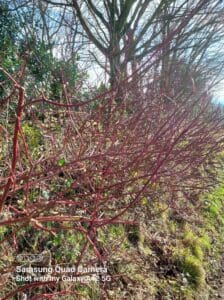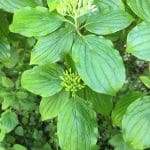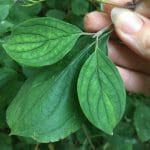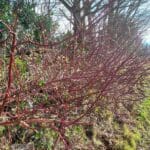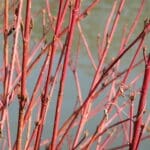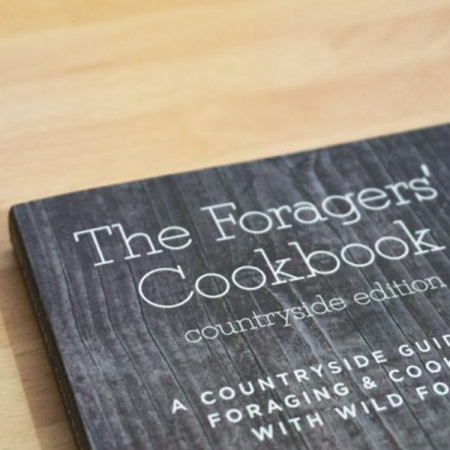Common Dogwood / Spring / Summer / Autumn / Winter / Toxic
The Common Dogwood (Cornus sanguinea) is a familiar sight in hedgerows, woodlands, and gardens across the UK, admired for its vibrant red stems in winter and clusters of creamy white flowers in spring. As the seasons turn, its dark purple-black berries may catch the eye of curious foragers.
However, while wildlife such as birds enjoy these fruits, they’re not suitable for human consumption and can cause digestive discomfort if eaten.
Beyond its inedible nature, Common Dogwood plays an important ecological role, providing food and shelter for a variety of species.
In this post, we’ll explore how to identify Common Dogwood, appreciate its beauty, and understand its place in the natural world—while keeping it off your foraging list.
Common Names
Common Dogwood
Botanical Name
Cornus sanguinea
Scientific Classification
Kingdom – Plantae
Order –Cornales
Family – Cornaceae
Physical Characteristics of Common Dogwood
Deciduous shrub usually reaching about 3m tall, growth is upright and straight, easily recognised by its decorative red shoots in winter and curved leaf veins.
Leaves
Simple and oval shaped about 6 cm long, they have a smooth leaf edge and characteristic curving veins. Fresh green, fading to a rich crimson colour before falling in autumn. When the leaves are pulled apart a stringy latex can be seen.
Stem
Bark is gray and smooth, with ridges as it ages. The new shoots are bright red in the sun and bright green in the shade.
Flowers
Dense clusters of creamy white flowers. Each flower is the shape of a cross with 4 slim petals and 4 long stamen. The flowers have an unpleasant smell.
Fruit
Clusters of pea size black berries sometimes called dog berries. These are borne on short red stems, and have a dot on the bottom
Habitat
Dogwood is native throughout Europe, Asia and North America. It can grow in many soil conditions but thrives in damp woodland edges, and hedgerows. It is also a popular ornamental plant used in gardens for autumn and winter colour as the new shoots are bright red in the sun and bright green in the shade. Various different bark colours from yellows, oranges, lime greens to blacks can now be seen in ornamental planting
Known Hazards
The sap in the leaves can cause irritation in some sensitive individuals.
Could Be Confused With
The clusters of black berries which look very similar to Elderberries, the leaves will tell you the difference straight away as they are totally different. Elder has compound leaves with 5-7 leaflets and a serration to the leaflet edge. Dogwood leaves are simple, with a smooth leaf edge and curved veins.
Edible Uses
Not edible- Though not toxic as such the berries can cause gastrointestinal upset and even vomiting in some so definitely best left.
Notes on Herbal uses
The bark of all Cornus species are rich in tannins and have been used in traditional medicine as a substitute for quinine – a drug that’s used to treat malaria and babesiosis. A drink similar to tea can be made from the bark to treat pain and fevers, while the leaves can be made into a poultice to cover wounds.
Extra notes from the Foragers
The timber is so hard, it was used for crucifixes, apparently Jesus was crucified on a cross made of dogwood
The origin of the name comes from the straight twigs being used as butchers skewers. They were called ‘dags’ or ‘dogs’, so the name means ‘skewer wood’.
The leaves are eaten by the caterpillars of some moths, such as the Case-bearer moth, the flowers are visited by insects and the berries are eaten by many mammals and birds.
The wood of Dogwood is extremely hard and can be used for skewers and to make the handles of tools or anything that requires strong wood.
A green blue dye can be obtained from the fruit.
The young stems are very flexible and are great for basket weaving.
The seeds contain a non drying oil that is used in soap making and for lightning.
Resources
https://www.rhs.org.uk/plants/4408/cornussanguinea/details
http://www.naturalmedicinalherbs.net/herbs/c/cornus-sanguinea=dogwood.php



